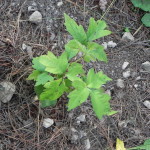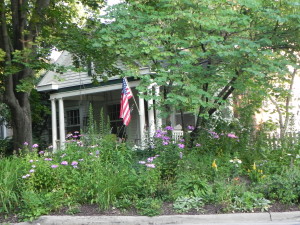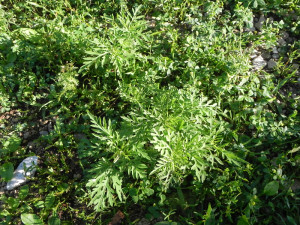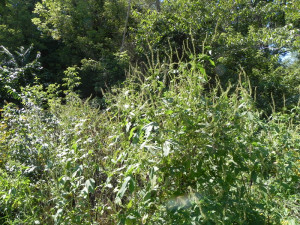by Winding Pathways | Aug 19, 2014 | Flowers/Grasses, Nature

These beneficial wildlife plants are the bane of unsuspecting gardeners.
Few plants cause as much human misery as poison ivy. Direct contact with the allergenic oil on its leaves or in its roots or stems can cause itchy welts in people.
Poison ivy is as tricky as it is common. Most outdoor people know to avoid it when it’s growing rapidly in spring but forget about it the rest of the year. We’ve gotten a poison ivy rash in nearly every month and most commonly get a good case in late spring when we’re working in the yard and garden. The plant is sappy then and when we’ve inadvertently pulled the roots out of the ground without wearing gloves we’ve gotten rashes. But late summer into fall are also prime times to get poison ivy rash. Birds eat the seeds which they drop in excrement and the new plants take hold in summer’s lushness. Gardeners encounter the new plants during deep-season weeding or fall “tuck-in” time.
Poison ivy is common in urban and rural areas. It is highly adaptable, preferring light shade, but also thriving in full sun and dense shade. Usually it hugs the ground, but it can grow to a shrub six feet tall or a vine that climbs to the top of trees. It likes to hide inside the greenery of urban hedges. Poison ivy usually has three leaves and is often confused with five-leafed Virginia creeper.
Humans must come in physical contact with the plant or its oil (urushiol) to end up itching. Inhaling smoke laced with poison ivy is asking for trouble. People generally contract poison ivy from tools, pets, farm animals and clothes that have contacted the plant. Any season is game. The Centers for Disease Control and Prevention has an excellent page on range of the plant and its cousin poison oak as well as poison sumac, symptoms, prevention, and care of tools that have been used in extricating poison ivy. Avoiding contact is the best way to prevent a rash. If bare skin comes in contact with the plant immediately wash the area with plenty of soap and warm water.
Despite the misery it causes humans, poison ivy is valuable to wildlife. Deer and cottontails readily eat it, especially in the winter. Birds devour the seeds helping to spread it around in their droppings. Birds like to perch on small end branches of trees so, we’ve learned to look up and assess the likelihood of contacting poison ivy shoots before plunging into a weedy flower bed.
The plant has another merit. Its leaves are one of the first to turn color in early fall, often to a brilliant red. Spot a patch of bright red leaves close to the ground in September and chances are they are either poison ivy or nonpoisonous smooth sumac.
by Winding Pathways | Aug 6, 2014 | Bugs, Flowers/Grasses, Nature, Trees/Shrubs, Weeds, Wonderment

This lovely landscape adds beauty to the neighborhood and welcomes pollinators.
Worldwide concern over dramatic declines in honeybee populations the past few years have hit the news. These intriguing and highly beneficial insects pollinate thousands of species of flowers, but media reports lead us to believe that they are the only pollinator and the disappearance of honeybees will leave plants unable to pollinate. The result will decimate human food supplies.
That’s only true in context. Honeybees are Old World natives introduced to North America in early settlement days. Before Columbus there were no honeybees on the continent, but obviously plants pollinated, thanks to dozens of other insect species as well as a few mammals.
Honeybee loss is of huge concern to anyone who likes to eat because of the way our society farms. Immense monoculture orchards and fields lack habitat for native pollinators. Farmland is often doused with insecticides. Farmers place honeybee colonies in the midst of vast almond and fruit orchards as well as other crops to pollinate these giant biological deserts that can’t support other pollinator species.
Fortunately, there are ways homeowners can welcome pollinators to their yards.
Become a beekeeper. It’s a fascinating hobby that yields satisfaction, pollination and delicious honey. Learning beekeeping takes effort and may not be legal in some cities. Look for future Winding Pathways blogs on beekeeping or contact your local extension agent or nature center to learn about beekeeping classes and locate experienced beekeepers. Beekeepers are usually eager to mentor newcomers.
Create pollinator homes. Mason bees are efficient, fascinating pollinators that are easy to attract to yards. While they do not yield honey they do get the pollination job done. Mason bees lay eggs in cavities in wood and readily use nesting structures placed in a yard. Most garden supply companies sell mason bee “houses” made of many tubes joined together. A mason bee home can be easily made from scrap wood. We made ours from several pieces of scrap 2X6 lumber screwed together to form a thick short piece of artificial tree. We drilled holes in it for the bees to raise their larvae, painted it and hung it from our deck. A few bees used it the first season with more moving in the next year. Google “Mason Bee” and choose from the many plans.
Create a pollination pocket, or PP, in the yard. Many pollinators only need a small patch of tall vegetation to hide in and raise their young. Mowed and sprayed lawns lack pollinator habitat. Often vast subdivisions are so manicured that hardly a beneficial insect can live there. So, to create the simplest PP just stop mowing a strip of lawn and let grasses and weeds grow tall there. The bigger the patch the better but even a 10 or 20 foot long and two foot wide strip will house pollinators.
The downside of letting a patch of lawn grow up is that plant species diversity will be limited and problem weeds may grow. Pollinators love weeds, but neighbors don’t. Be creative. The greater the diversity of flowers the more colorful the PP will be, the more beneficial insects it will attract and the more neighbors will like it. Our PPs include a wide variety of native grasses and wildflowers. Because we live in Iowa many of our plants are native prairie species but we also encourage some ornamental exotic flowers. One of our favorites is the cupplant. It’s tall and gangly but dozens of insect species love it. So do goldfinches and hummingbirds! On most sunny summer days tiger swallowtail butterflies and bumblebees visit it. Goldenrods and milkweeds are also outstanding pollinator plants.
A PP can serve many purposes. Tall, colorful patches of flowers and grasses can form walkway boundaries – winding pathways – in the yard and also can put steep or rough hard to mow areas to good use. A PP does more. The plants sink roots deep into the earth holding soil and creating space for rainwater thus reducing runoff. For a tranquil evening activity, sit quietly near a pollination pocket with a pair of binoculars that will focus closely and enjoy the constant coming sand goings of dozens of species of intriguing insects.
Take a step in creating a wondrous yard by creating a pollinator pocket. It will add summer color to the yard and invite all sorts of delightful and helpful insects to cohabit your space.
by Winding Pathways | Jul 14, 2014 | Flowers/Grasses, Nature, Weeds

Common Ragweed
Late summer is the dreaded hay fever season! Ragweed is the prime culprit.
Two species of ragweed account for most of the misery. Both are annuals that reseed each year. The seeds only need a bit of bare ground to sprout. They are not fussy, thriving in nearly any type of soil.
True to its name, Common (sometimes called Eastern) Ragweed can be found nearly anywhere people live, especially cities. It can be a prostate plant hugging the ground or sidewalk edge or grow to two or three feet tall on the edge of a yard. Giant (sometimes called Western) Ragweed is less common in suburban and urban areas and can grow to upwards of eight feet tall. It’s abundant on the edge of farm fields where it often forms large thickets. In urban areas Giant Ragweed is most likely found in industrial areas and along railroad tracks. Despite their names either species can be found nearly anywhere in North America, where they are a native plant. Unfortunately ragweed has been introduced to Japan.

Giant Ragweed
Ragweed causes human suffering because in late summer plants produce green flowers that release millions of pollen grains to the wind. Allergic people react after breathing in the tiny grains, which can blow for miles from the parent plant.
Goldenrods are frequently blamed for causing hay fever because of an unfortunate coincidence. They bloom during hay fever season. Goldenrod flowers are a bright yellow, designed to attract pollinating insects. They do not release pollen into the air and are unjustly blamed for causing human misery.
Despite causing hay fever, ragweeds have ecological value. They are a pioneer weed that quickly becomes established on bare soil. Roots hold the soil, preventing erosion. Within a few years ragweeds usually vacate the spot as more stable perennials move it. Ragweed seeds are devoured by many bird species such as quail.
As a general rule any plant that produces unshowey flowers is a wind pollinator that could cause human allergies. This includes many grass and tree species as well as ragweed. In contrast plants that produce colorful showy flowers are normally insect pollinated and don’t cause sneezing.
by Winding Pathways | Jul 14, 2014 | (Sub)Urban Homesteading, Flowers/Grasses, Foraging, Nature
Dandelions by the millions pop up like magic in lawns, along roadsides, and just about anywhere else that sunlight reaches bare soil. They are probably the most recognized and widespread plants in the world.
A Eurasian native, dandelions reached North America as precious garden seeds brought across the ocean by our earliest immigrants. They began spreading across the continent before the Revolutionary War. For thousands of years people appreciated the dandelion’s culinary and medicinal properties. Its Latin name, Taraxacum officinale, means “official remedy for disorders.” Imagine living in Europe during the Dark Ages. Winters were cold and dark. Diets were monotonous and lacked vitamins. By late winter many people suffered severe vitamin deficiencies. They were weak, lethargic and vulnerable to fatal diseases. Then, with the first few warm days vitamin rich dandelions began growing. People ate them and vitamin deficiencies evaporated. This humble plant restored health. No wonder immigrants carried dandelion seeds across the ocean when they immigrated to the New World! How ironic that a plant that can do no harm to humans and once provided important food and medicine is today hated. If dandelions were finicky and needed special cultivation and care maybe homeowners would appreciate them! Children love bright yellow dandelion flowers and delight in blowing seeds off the puffy sphere that follows the bloom. Instead of persecuting dandelions perhaps we’d all be better off it we took a lesson from kids and just enjoyed them.
Why Dandelions Invade Lawns
In order to thrive in a lawn, dandelions need two conditions: a scrap of bare soil and sunshine. When meticulous homeowners attempt to create a monoculture lawn by mowing closely, removing lawn clippings, and aerating the soil they create perfect growing conditions for dandelions. Fluffy dandelion parachutes carry millions of dandelion seeds through the air which land nearly everywhere. If growing conditions are not good where the seed lands it won’t thrive. But if the seed has the good fortune to descend onto a closely cropped lawn, it will quickly sprout and flower to the consternation of the owner. They poison and dig out the dandies and mow the lawn to the nubbin, creating more perfect conditions for new seeds to sprout. Dandelions are probably the world’s best plant for the herbicide industry!
Reducing Dandelion Populations in an Ecological Lawn
A nonsprayed lawn is always likely to have a few dandelions, but the best to manage a lawn to reduce plant numbers is to keep the ground shady and avoid bare soil. Follow these easy steps:
- Avoid herbicides.
- Set the mower cutting depth high to allow grass to grow tall, shading the soil beneath. Mow as infrequently as possible. Leave clippings in place and never remove “thatch.”
- Avoid bare soil whenever possible.
- Eat them. Dandelions are good food!
- Let kids pick the flowers.
Eating Dandelions
Timing is the secret to enjoying this nutritious plant. Most people know dandelions can be eaten. But, the few adventurous people who have tried them often are repelled by the plant’s bitterness. Dandelions, like most other edible greens, are best when the leaves are very young. Pick them in early spring just after they’ve started growing. Bitterness sets in as the leaves mature and the weather turns hot. The best dandelions were covered by leaves in the fall and are semi-blanched when picked in spring. Mix cleaned baby dandelion leaves into salads for a peppery zing or boil as a potherb. Young leaves are best and require the least amount of work. Steam them changing the water twice. Season with butter, salt and pepper as desired. Some folks toss the greens with chopped bacon. They are tasty. Older dandelion leaves can also be eaten but must be cooked in several changes of water to remove the bitterness. Gather mature leaves. Bring a saucepan of water to a boil and put the washed leaves in. Boil for a few minutes while bringing another saucepan of water to a boil. Remove the leaves from the first pot, drain, and add them into the clean boiling water. It may take two or three water changes, but eventually the bitterness will disappear. Season as desired. Dandelion roots are also edible and can be made into a coffee-like substitute. Consult a wild foods book for details.
by Winding Pathways | Jul 14, 2014 | (Sub)Urban Homesteading, Flowers/Grasses, Garden/Yard, Nature
Hot moist weather is a boon to crabgrass. This European native was brought to America centuries ago and is a hated lawn and garden weed.
Crabgrass is an annual that sprouts as soon as moist soil reaches about 60 degrees. It dies at first frost but not before producing thousands of seeds that persist in the soil a long time waiting for proper growing conditions. Rapidly growing crabgrass can quickly overwhelm a vegetable garden or make a lawn look splotchy.
Crabgrass grows close to the ground. When its nodes touch the soil they quickly take root, enabling the plant to rapidly expand outward. Homeowners seeking the perfect lawn ironically create perfect growing conditions for the weed. Because it hugs the ground close mowing stresses desirable grass species while favoring prostrate crabgrass. Shallow watering also helps the shallow rooted annual.
Crabgrass comes with benefits. It reduces erosion by quickly covering bare soil, and many species of domestic livestock and wildlife enjoy munching its leaves. Some wild animals enjoy its plentiful seeds.
Herbicides can reduce crabgrass abundance but it’s virtually impossible to eliminate it from a lawn or garden. Hand pulling will keep it away from tomatoes and beans, and setting the mower higher may reduce its lawn abundance.
When you find crabgrass in your yard consider this: Crabgrass is like Mother Nature’s stitches. Severely cut your hand or leg and the doctor will hold the wound closed with stitches. When homeowners bare the soil, they make it vulnerable to erosion. Think opening a wound. Enter crabgrass. It grows amazingly fast on bare soil and keeps it in place during heavy rains. Crabgrass has its place in nature, and we should all appreciate those plants able to quickly colonize and stabilize soil.




